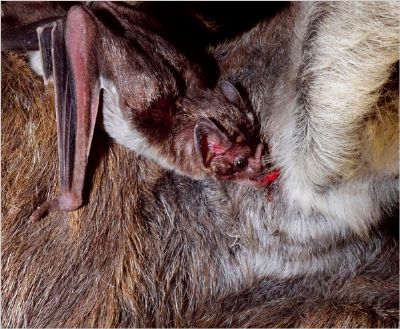Vampire bat modus operandi
Vampire Bats’ tactics are similar to that of a vampire in that it feeds at ground level and attempts to hypnotize its prey before gloming itself to a vein and lapping up blood with its long tongue. Vampire bats do not actually “suck” the blood of their victims, instead simply lapping up the blood that oozes from their bites. Normally such blood would rapidly clot when exposed to air but Vampire Bats employ an anticoagulant enzyme in their saliva that keeps fresh blood from clotting. The substance, named by a somewhat over-enthusiastic researcher, is called Draculin.
Each vampire bat, whatever the species, needs about two tablespoonful of blood every day. This represents about 60% of the bat’s body weight, or 20 g of blood.

There is a heat (infrared) sensor on the nose-leaf of Common Vampire Bats, permitting them to locate an area where the blood flows close to the skin. The bats extract this blood through a wound they make with their front (incisor) teeth.
The wounds are approximately 5 mm deep and 5 mm in diameter and do not cut arteries or veins. The bat then begins to use its tongue in the wound as well as its saliva. The action of his tongue keeps blood flowing, while grooves on the underside of the tongue draw blood toward the bat’s mouth.
Meanwhile, the saliva has at least three active ingredients that promote bleeding. One is an anticoagulant that counters the clotting defenses. A second keeps red blood cells from sticking together and a third inhibits the constriction of veins near the wound. It may take the bat about 20 minutes to fill its stomach.
Usually within two hours of setting out, the Common Vampire Bat returns to its roost and settles down to spend the rest of the night digesting its blood meal. It appears that vampire bats are “one stop shoppers,” feeding on one victim each night. Getting 20 g of blood from a wound that normally produces just one drop is a specialized business. Being warm-blooded, common Vampire Bats cannot survive two nights without meal, so fasting is dangerous
A Venezuelan research team have isolated a previously unknown anticoagulant glycoprotein from Desmodus rotundus (the common vampire bat). This substance targets activated forms of blood coagulation factors, thus inhibiting them immediately. Named “draculin,” this anticoagulant agent promises to be significant in the development of improved drugs to fight heart disease and stroke.
